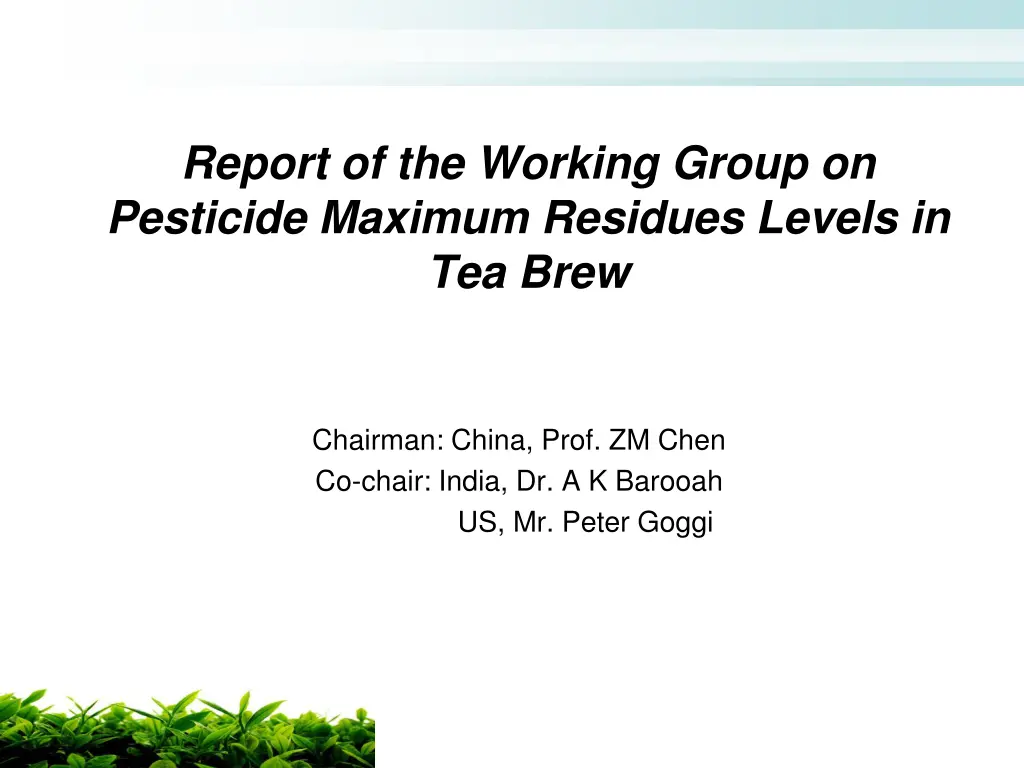
Pesticide Maximum Residue Levels in Tea: Key Findings and Action Plans
Explore the outcomes of the Working Group on Pesticide Maximum Residues Levels in Tea Brew, including the establishment of MRLs, organization of ring tests, and action plans for a more rational MRL environment in the global tea trade.
Download Presentation

Please find below an Image/Link to download the presentation.
The content on the website is provided AS IS for your information and personal use only. It may not be sold, licensed, or shared on other websites without obtaining consent from the author. If you encounter any issues during the download, it is possible that the publisher has removed the file from their server.
You are allowed to download the files provided on this website for personal or commercial use, subject to the condition that they are used lawfully. All files are the property of their respective owners.
The content on the website is provided AS IS for your information and personal use only. It may not be sold, licensed, or shared on other websites without obtaining consent from the author.
E N D
Presentation Transcript
Report of the Working Group on Pesticide Maximum Residues Levels in Tea Brew Chairman: China, Prof. ZM Chen Co-chair: India, Dr. A K Barooah US, Mr. Peter Goggi
1. The attempt and acceptance of using the brewing factor in the establishment of MRLs in dry tea Documents entitled Assessment of MRLs for pesticide residues in tea and Assessment of MRLs for Pesticide in Tea were adopted by CCPR and concluded in CCPR report in 2011 and 2012 The MRL of indoxacarb in tea was established as 5 mg/kg and adopted by CCPR and CAC in May and August of 2014, respectively. This successful attempt illustrated the concept of considering the residue level in tea brew to establish the MRL in dry tea has been accepted by the regulatory authorities such as the CCPR and JMPR.
2. Organization of Ring test to determine the pesticide in tea brew Black tea sample incurred with 4 pesticide residues (acetamiprid, propiconazole, fenpyroximate and flubendiamide) was prepared by India, 14 labs participated in. Green tea sample incurred with 3 pesticide residues (imidacloprid, tolfenpyrad and difenaconazole) was prepared by China, 4 labs participated in. The results of black tea will be complied by India and the results of green tea will be complied by China.
Action Plans 1. Establishment of the methodology to determine the pesticide residue in tea brew Ring test organized by India and China covers 2 different methodologies to determine the pesticides in tea brew. However, the incurred 7 pesticides in tea brew were determined in black tea/green tea and different sample preparation procedures Expect labs from tea producing and tea consuming countries to participate in Ring Test
2. Continue to create a more rational and scientific MRL environment in tea in the world tea trade Enough evidences have demonstrated that many current MRLs in tea would overestimate the risk of pesticide residues consumed since dry tea would not usually be consumed raw Cooperation to establish the methodology and procedure of using the residue level in tea and tea brew to establish the MRL in tea, as the drafted policy document of Guidance Document on Risk Assessment Using Brew Factor for MRL Fixation in Tea






















